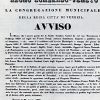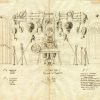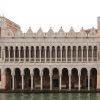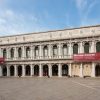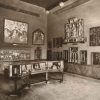The Museo Correr takes its name from Teodoro Correr (1750-1830), a passionate art collector who was a member of an old family of the Venetian aristocracy. When he died in 1830, he donated to the city not only his works of art, but also the palazzo at San Zan Degolà in which they were housed, plus funds to maintain and further extend a collection which was to bear his name and ultimately became the core around which the Musei Civici di Venezia developed. Correr’s will was explicit about when and under what conditions his house was to be open to the public and to scholars, how many people were to work in maintaining the collection, and even what funds were to be used for this purpose. These precise instructions indicate that what he had in mind was not only a place of scholarly research, but also a veritable museum, a place in which to collect, conserve and exhibit works of various kinds.
However, initially the collection was not on display to the public as an organic whole; and though it was opened as early as 1836, it was only with its third curator, Vincenzo Lazari, that one can say it became a proper museum. The objects within the collection were subdivided according to kind and carefully catalogued; and at the same time Lazari included new donations, purchased works with the museum’s funds, and promoted restoration projects. As a result, the museum was laid out as both a place of study for scholars and as an exhibition gallery containing noteworthy works and artefacts (in Lazzari’s own words “the best of what there is in each individual collection”). And although the curator was responsible for destroying objects and documents which he felt were not keeping with the good name of the museum’s founder, it was due to his work that by the second half of the 19th century, the Museo Correr had become a necessary stop point for any scholar or visitor coming to Venice.
Thereafter, the collection continued to grow through donations, bequests, and acquisitions. From this core collection, the modern-day Musei Civici di Venezia would gradually emerge; and a series of different collections would eventually become a vast network of museums spread throughout the city. Extended as a result of various donations – including the Molin, Cicogna, Sagredo, Zoppetti, and Tironi collections (the latter two respectively comprising works by Canova and a range of paintings, bronzes and glass and ceramics) – the museum was first moved in 1887 from the Palazzo Correr at San Zan Degolà to the nearby Fondaco dei Turchi, with the entire layout of the exhibits being redesigned. Further additions around this time included the 1895 acquistion of the substantial archive and collection relating to Francesco Morosini. In the meantime, on the occasion of the second Venice Biennale, the Venice City Council had begun the Muncipal Collection of Modern Art; and in 1902 the designated home for that collection became Ca’ Pesaro, a prestigious baroque palazzo donated to the city by Duchessa Felicità Bevilacqua La Masa, also housing the paintings collection dating from the second half of the 19th century which Pompeo Molmenti left to the city in 1927.
In 1922, the Museo Correr was moved once again, to its present-day home in St. Mark’s Square, occupying the Napoleonic Wing and part of the Procuratie Nuove. It was, in fact, Molmenti – then Under-Secretary at the Ministry of Arts – who fought to make this location available. At the same time, the Fondaco dei Turchi became the Natural History Museum, whilst in 1923, Palazzo Giustiniani in Murano was acquired to become a Glass Museum. The various different glass collections would be relocated there in 1932. In the meantime, the State had conceded the management of the Doge’s Palace to the Venice City Council.
In 1931, Ca’ Centanni – the house in which Carlo Goldoni was born – was donated to the city, and Ca’ Rezzonico was acquired one year later. Destined to house a museum of 18th century Venice, this museum space was designed by Giulio Lorenzetti and Nino Barbantini, and in 1936 the various 18th century artworks from the Correr collection were transferred there, along with other more recently acquired material. In 1945, Alvise Nicolò Mocenigo donated his ancestral home at San Stae to the city. The Casa di Carlo Goldoni opened to the public in 1952; and in 1956, Henriette Fortuny left Mariano Fortuny’s collections and studio to the City Council. The Fortuny Museum opened in 1975, and six years after the Lace Museum opened in the old Scuola di Andriana Marcello in Burano. The museum of Palazzo Mocenigo opened to the public in 1985, together with its associated Centre for the Study of Fabric and Costume.
In the 1990s, this entire system of the city’s museums was renewed, with all the individual collections coming under a unified organisational structure.
